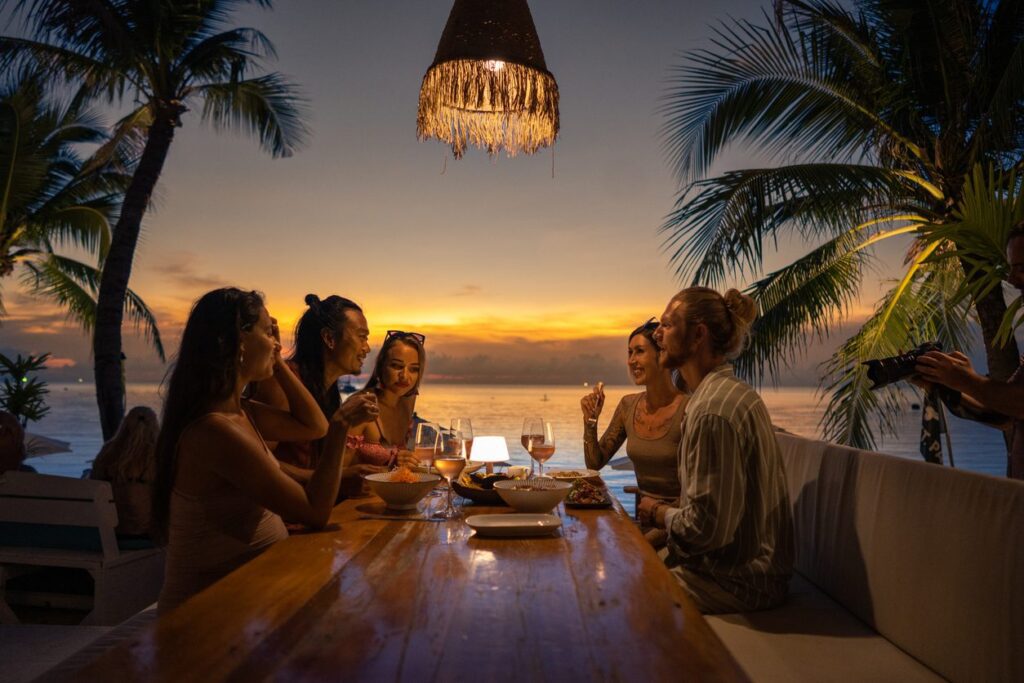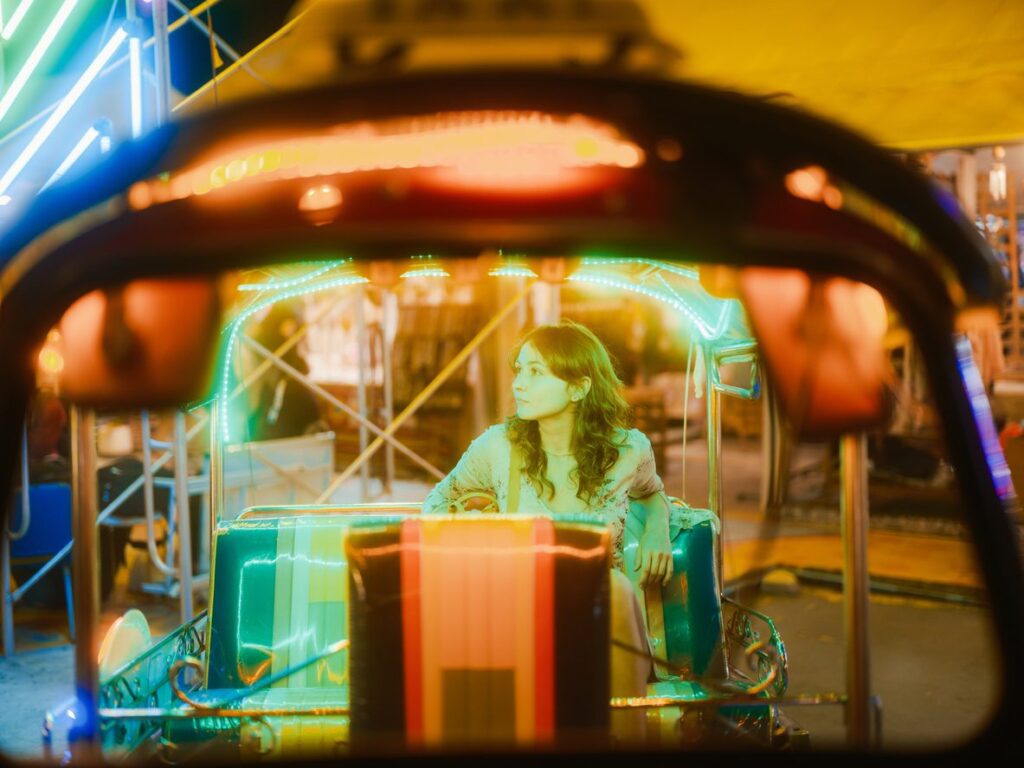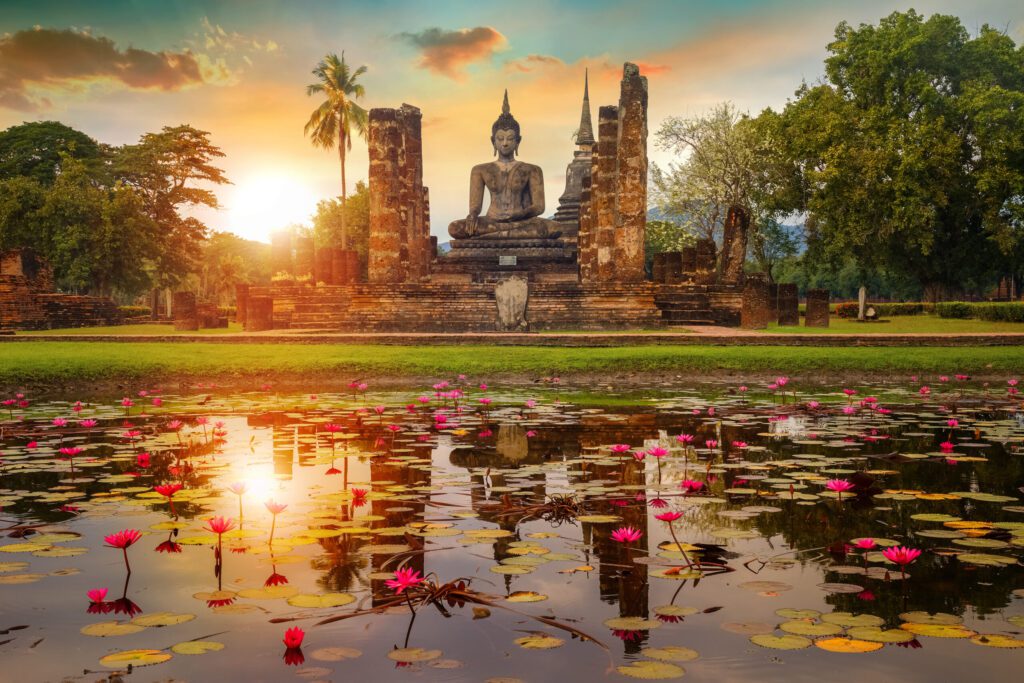a guide to Sukhothai
Arguably the Thai Kingdom’s first capital, Sukhothai is one of the country’s most important cities, with a lasting cultural and architectural legacy. A UNESCO World Heritage City with a vast number of historical sites and temple ruins, the province has plenty of archaeological evidence pointing to it being the first empire by Thai people to develop a written language, hence the birth of the Thai alphabet. As its name translates to, the ‘dawn of happiness’ is as spectacular and diverse as other provinces.
Named after the kingdom that ruled the area from 1238 to 1438 and was the cradle of Thai civilization, the modern-day Sukhothai is in the Yom River valley. It is 300 kilometers south of Chiang Mai and 440 kilometers north of Bangkok.
Historically, the province used to be home to ancient chinaware, with crucial archaeological findings in different parts. While the production crockery has resumed using modern-day facilities and old-fashioned skills, the traditional manufacture of silverware and ancient gold jewelry remains a delicate business done by a few craftsmen and women. The architectural style of the era still substantially impacts today’s Thai art scene.
Located halfway between Bangkok and Chiang Mai, Sukhothai is a popular stop for people traveling between the two cities. Visitors can also fly into the privately-owned airport operated by Bangkok Airways, which has made Sukhothai easily accessible for years. Currently, the Organic Agriculture Project within the airport’s compound has also become one of the emerging destinations you won’t want to miss.
A quiet rural city where you can still relish the charms of rustic lifestyle, Sukhothai was added in 2019, together with Bangkok, to the UNESCO Creative City Network. It received designation as a new ‘Creative City of Crafts and Folk Art.”
Getting there
Sukhothai is about 440 kilometers away from Bangkok or approximately five and a half hours by car.
Bangkok Airways flies twice weekly from Bangkok to Sukhothai during the low season (April to October), with one more flight added from the end of October until March.
Website: https://www.bangkokair.com/flightdeals/view/sukhothai
Telephone: Bangkok Office +662 270 6699 (24 Hours)
Email: reservation@bangkokair.com
Telephone: New York Office +1-866-BANGKOK (226-4565)
Email: nyc@bangkokairwaysna.com
Bus service by Transport Co., Ltd, or locally known as ‘Bor Kor Sor,’ leaving Mo Chit Bus Terminal 2 to Sukhothai Bus Terminal runs from early morning till 10pm. It costs 338 baht and takes about six hours. Call +662 269 6999 or book through www.busticket.in.th (the website is in Thai).
Other companies also operate Bangkok-Sukhothai routes depending on your end destination in the province. Phitsanulok Yanyont Tour operates Bangkok-Sukhothai Historical Park air-conditioned bus service at counters 53-54 at Mo Chit Bus Terminal 2. Call +662 936 2924, +662 936 2925. Sukhothai Win Tour Limited Partnership provides Bangkok-Si Satchanalai and Bangkok-Sukhothai Historical Park bus service. Call +6655 611 039 (Head Office in Sukhothai), +6687 824 5144 or their Bangkok office at Mo Chit +6681 533 4402.
Getting around
The purple-pink ‘songthaew’ or pick-up taxi runs around the city center for four baht per trip. Between 6pm – 6am, negotiate for the flat rate price per trip. Tuk-tuks are also available. Motorcycle taxis run for between 20 and 100 baht, depending on the distance.
You will find bus terminals to different districts around the main fresh market in the city. Eddy Rent A Car provides car rentals with chauffeur service available. Call +6681 534 1535. For motorcycle rental, try Ruengsrisiri (+6695 313 3083) opposite the Sukhothai Bus Terminal. The same company runs a guesthouse with showers if you feel like freshening up before inspecting the city.
Things To Do in Sukhothai
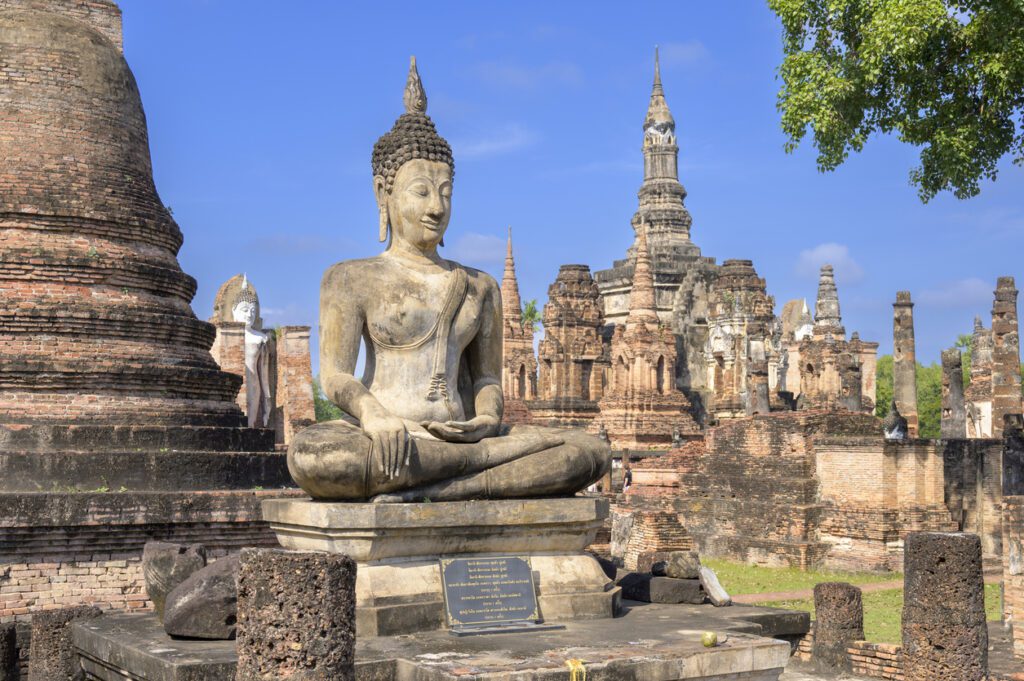
Sukhothai Historical Park is the province’s most famous attraction, covering the Sukhothai Kingdom’s ruins from its glory years between the 13th and 14th centuries. The city walls form a rectangle about 2 kilometers wide by 1.6 kilometers long, encompassing nearly 200 ruins on 70-square kilometers of land. In 1991, the park and associated historic towns of Si Satchanalai and Kamphaengphet were declared a World Heritage Site.
At the park, dozens of well-preserved and restored monuments are among lakes, ponds, and trees, adding some natural features to the area. The first independent Thai Kingdom was where Thai art and architecture developed into what is known as the Sukhothai style. It has a heavy Khmer and Singhalese influence. The lotus bud chedi and statues of a walking Buddha with clothing draped around the body are two main characteristics of the Sukhothai style.
A moat surrounds the old city, and the whole area contains the royal palace and several important temples. The ruins of dozens more are across several locations outside the walled area in various preservation states. A great deal of information about the history of the kingdom and its rulers came from several inscribed stone steles, including one belonging to King Ramkhamhaeng discovered during excavations in Sukhothai and vassal towns.
Wat Mahathat is the most important and probably the most impressive temple in the park, founded as the city’s main monastery between 1292 and 1347. ‘The temple of the great relic’ as it means, features the mandala design representing the universe—a principal stupa built in 1345 enshrined relics of the Buddha with eight smaller ones around it. The lotus bud shape of the main stupa later became a key characteristic of Sukhothai architectural arts. The monastery complex also includes 200 other smaller stupas.
A few hundred meters northwest of Wat Mahathat lies Sa Si Temple. Located on a small island in the middle of the lotus flowers-filled Tra Phang Tra Kuan pond, it is one of the most attractive monuments of the historical park. The small temple consists of a principal chedi, another smaller chedi, a vihara, an ubosot, and a Sukhothai-style walking Buddha image. The idyllic location makes Wat Sa Si a focal point during Loy Krathong Festival’s Light & Sound Celebration.
Noen Prasat or ‘The Palace Hill’ is the remains of the Sukhothai Kingdom’s royal palace. Built on a 200 x 200-meter square base, it was discovered in 1833 by King Rama IV when he made a pilgrimage to the north of Siam as a monk. It featured two small ponds nearby where archaeologists found the remains of terracotta pipes believed to supply water from a lake to the ponds..
One of the oldest temples in the province, Si Sawai, was founded between the late 12th and early 13th century as a Hindu shrine for Vishnu, before the Sukhothai Kingdom’s foundation, with three laterite prangs representing the Hindu trinity. The Hindu and Khmer styles influenced the temple’s design. Numerous Chinese porcelains and Hindu god statues were also in the area.
Sukhothai Historical Park is 439.7 km north of Bangkok, about five and a half hours by car. From Sukhothai Airport, it takes 37 minutes to drive to the park, about 39 kilometers away. The admission fee is 100 Baht. The guided shuttle tour (+6686 440 9210), privately run, costs 60 Baht. The park is open from 6am – 7.30pm, but the ticket office is closed after 6pm. Only on Saturdays, extended opening hours are until 9pm. The park illuminates, making it even more fascinating to explore.
A group of visitors can request a tour guide providing details of each attraction. Contact the park at +66 5569 7527 and +66 5567 9310.
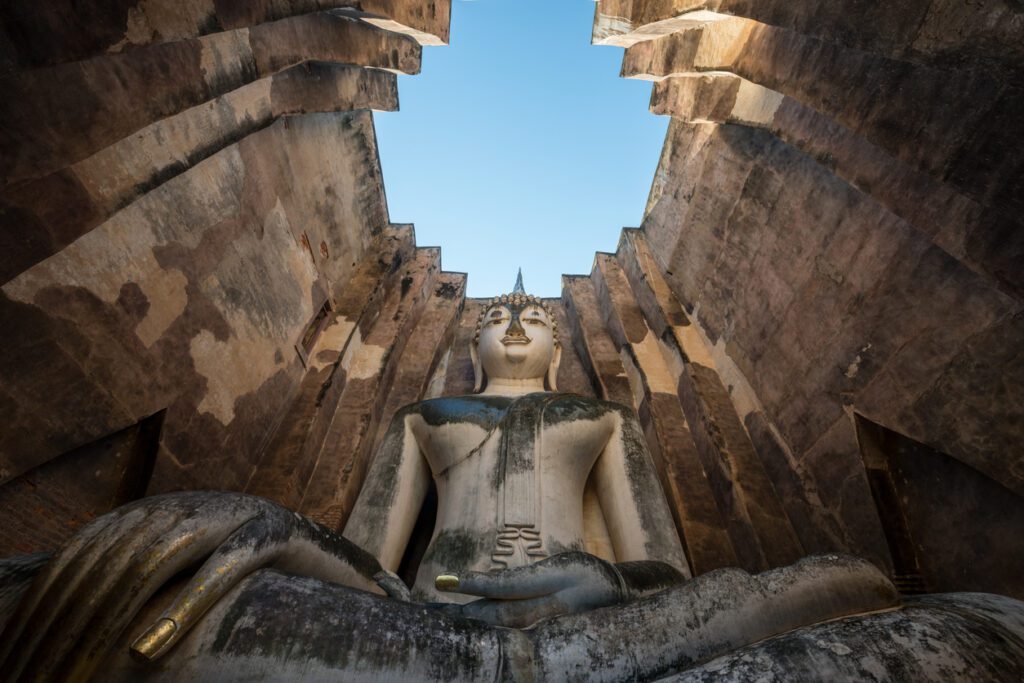
One of the most used attractions to promote Sukhothai and Thailand is ‘Phra Achana,’ an 11-meter-wide and 15-meter-high seated Buddha statue inside the massive mandapa in the middle of the complex belonging to Wat Si Chum.
Phra Achana looks like an enormous Buddha peering through a narrow opening in the ruined chamber from a distance. The mandapa has a square base of 32 meters on each side with a three-feet thick wall with a narrow staircase leading to the roof. It has collapsed over time, leaving the Buddha to sit serenely beneath the open sky. More than 50 slates were discovered in the passage on which engraved images depict Buddha’s life. It is believed to be the oldest surviving example of the Thai art of drawing. A moat surrounds the entire complex. Legend has it that to boost ancient soldiers’ morale during the war-prone period, the king went through the hidden passageway, addressing the people through a hole. He did this to make them believe the voice they were hearing was the Buddha’s. Another legend is that a contingent of the Burmese Army, while invading Sukhothai, fled upon seeing the statue.
To some, Phra Achana is the country’s most perfect Buddha statue. Meaning ‘Buddha who is not frightened,’ the name Phra Achana is mentioned in an inscription found in Wat Si Chum archaeological site. Phra Achana also goes by another name, Phra Poot Dai, meaning the ‘talking Buddha statue.’
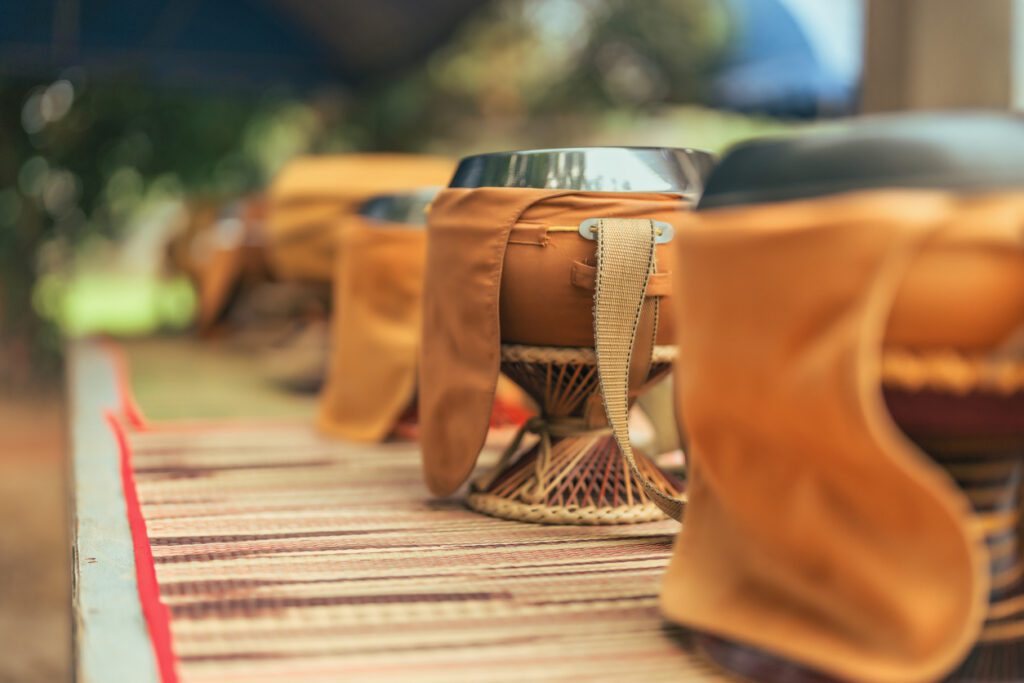
It’s traditional for Buddhists to perform the early morning ritual of providing food alms to monks from temples in their neighborhood.
At the splendid Sukhothai Historical Park, you can witness the traditional way of life. Wat Trapangthong is a breathtaking setting, with a big pond of the same name making the area even more spectacular.
This memorable scene occurs daily on the wooden bridge, where locals prepare savory food, desserts, and flowers to give monks. At the Tapangthong market, they also sell foods for visitors wishing to join in on the custom. Be there before 6am if you don’t want to miss this great opportunity.
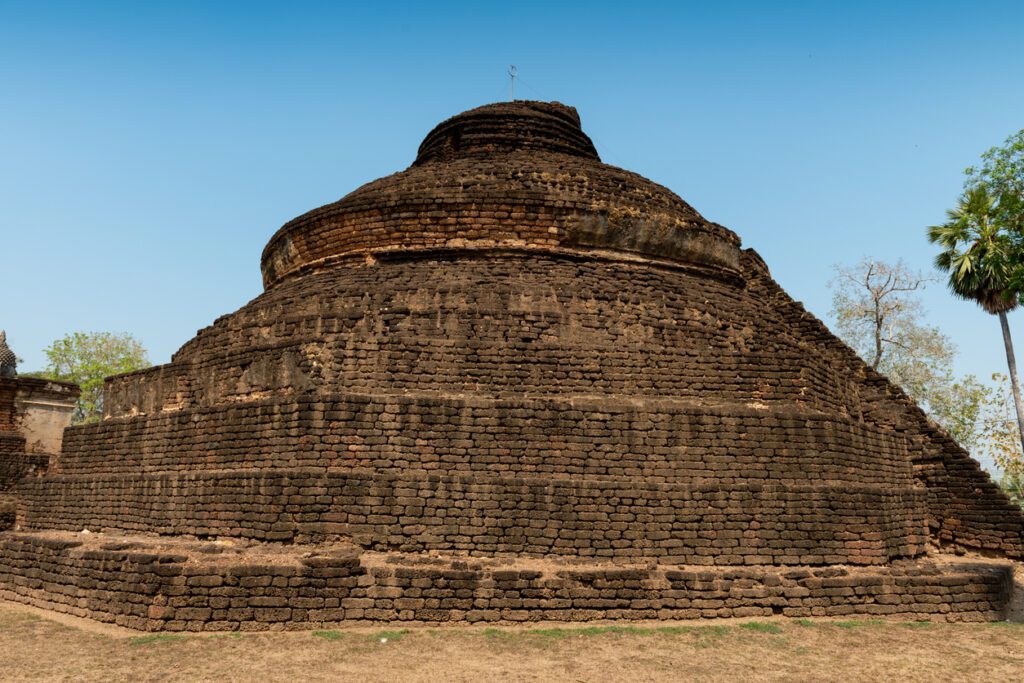
About 60 kilometers north of Sukhothai Historical Park lies another town with an equally magnificent historical park.
Si Satchanalai Historical Park spans across 11,150 acres with a wide array of Buddha structures and ancient buildings. On the Yom waterway, it appears equally well-maintained. Still, it looks raw in a characteristic, forested range across the ruins of Si Satchanalai and Chaliang. The former meaning ‘city of good people’ was founded in 1250 as the second center of the Sukhothai Kingdom. Rectangular in shape, the park was declared a World Heritage Site by UNESCO, together with associated historical parks in Kamphaengphet and Sukhothai.
Si Satchanalai is believed to have been home to another civilization as magnificent as Sukhothai. Archaeological evidence suggests that this ancient city used to be a center for ceramic trade with China.
Similar to Sukhothai Historical Park, but with fewer visitors, Si Satchanalai Historical Park is about 11 kilometers from Si Satchanalai town center. It is an open green space dotted with ancient temples and ruins. With an abundance of lush green countryside, it is a joy to bike around the park.
When the kingdom of Sukhothai rose to prominence, Si Satchanalai was built as a satellite city thanks to its strategic location. Thanon Phra Ruang road connected the two cities, and some Thai historians consider it the first highway in Thailand. Founded in 1250, Si Satchanalai was built on the Yom River banks and protected by two hills that provided lookout points to scout for enemies. As the city grew, stone walls and a moat were added to provide further protection. Sukhothai’s princes were sent to Si Satchanalai to rule this vital city in the Sukhothai kingdom.
Although Si Satchanalai is closely associated with the Sukhothai period of Thai history, archaeological finds suggest people inhabited the location as early as the third and fourth centuries. The area was then known as Chaliang. Visitors to the park can also see some Khmer-style ruins which predate the Sukhothai period. When the Sukhothai Kingdom fell, Si Satchanalai remained an important strategic location with the rival Ayutthaya and Lanna kingdoms battling on various occasions for control of the city.
Wat Phra Si Rattana Mahathat is the biggest and the most important historic temple in Si Satchanalai – Chaliang. One of the oldest monasteries in the park, it’s located east of the historic town in Chaliang, on a small peninsula. It was founded in 1237, predating the Sukhothai era. The temple was restored during the Sukhothai and Ayutthaya eras and is still an active monastery with monks residing there.
Wat Chang Lom is another distinctive temple, in this case, built in a Sri Lankan style. It is surrounded by elephants at the base and located in the central zone of the park. Founded in the 14th century during the Sukhothai period, it features a large Singhalese style principal bell-shaped chedi. It is believed to be the temple mentioned in a stone stele detailing how King Ramkhamhaeng dug up Buddha relics in Si Satchanalai and, after paying homage, reburied and had a chedi built over them.
Meaning ‘the temple of the seven rows of chedis,’ Wat Chedi Chet Thaeo is believed to be the funerary temple of the Si Satchanalai rulers. It was built between 1340 and 1350 by Sukhothai King Lithai, surrounded by a boundary wall with four gates. It is an attractive temple with numerous monuments in various styles, a vihara, a principal chedi, and 32 small ones.
Wat Nang Phaya is the first in a line of temples leading from the southeast wall. It has the best remaining portion of a wall, displaying the intricate stucco-work that once decorated all of the temples at Si Satchanalai.
It takes about 50 minutes by car to go from Sukhothai Historical Park to Si Satchanalai Historical Park along Route 1113. The park is open from 8am to 5pm, and the admission fee is 100 Baht. The guided shuttle tour costs 40 Baht. Contact the park at +66 5567 9211.
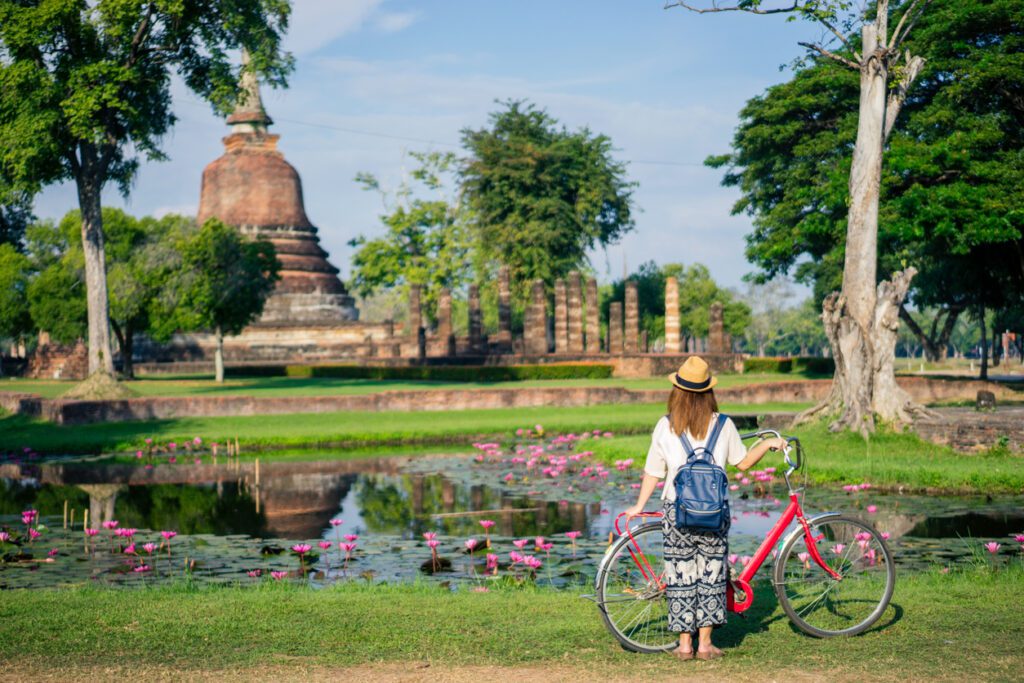
The best and recommended way to enjoy touring around Sukhothai and Si Satchanalai historical parks is on a bike. By biking around these two historical parks, you manage to see most of the sacred and religious sites, along with the rural surroundings.
Late afternoon, when the sun is lower in the sky, is the best time to visit these two parks. The park in Si Satchanalai is open until 7pm, meaning you may need to be there around 3pm to allow yourself ample time covering most of it. The sunset is a perfect moment to take pictures of the old ruins at Sukhothai Historical Park.
Visitors can rent a bicycle at each park. There are shops providing bicycle rental services opposite to the entrance of Sukhothai Historical Park. It costs around 40 Baht a day. At the opening of Si Satchanalai Historical Park, shops provide bicycle rental service for 20 Baht.
In case you want to explore Sukhothai more, some companies organize half-day and full-day tours, providing a variety of programs to suit individual interests.
One of the companies providing this kind of tour is Cycling Sukhothai Bicycle Tour. (Tel. +6655 – 612 – 519 / +668 – 5083 – 1864, e-mail: cycling_sukhothai@yahoo.com, facebook and website.
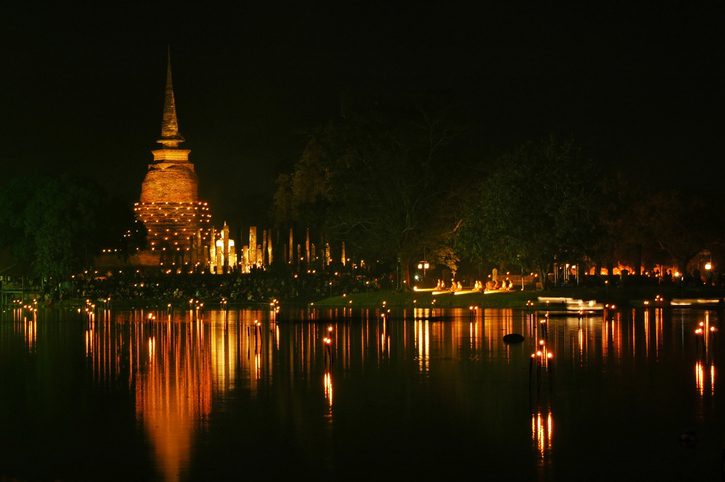
If timing allows, come to the Light and Sound at Sukhothai Historical Park held during holidays, including Loy Krathong.
Many locations within the park are used during the festival, while the main venue is Sa Si Temple. It is on a small island in the middle of the lotus flowers-filled Tra Phang Tra Kuan pond. Every year, the festival draws to the park tens of thousands of visitors who long to behold the most incredible light and sound spectacle in the kingdom.
Aside from Loy Krathong, you may have a chance to witness something less extravagant, yet equally exquisite, in the form of the Mini Light and Sound Performance. Usually, this runs between July to September. Contact the Tourism Authority of Thailand, Sukhothai office at +6655 616 2289 for information.
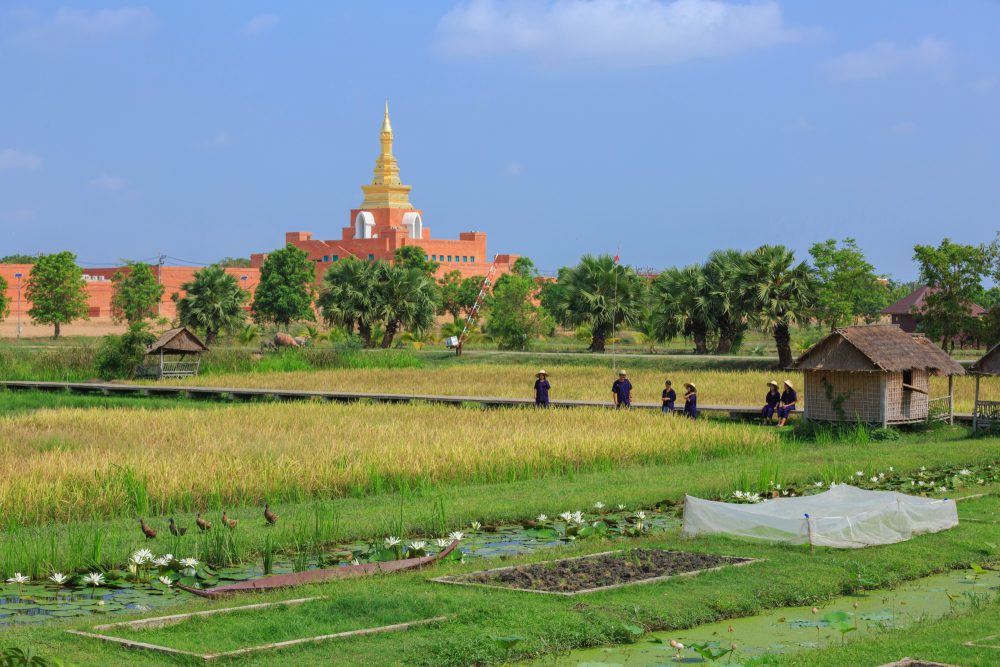
Sukhothai Airport was one of the main reasons the province has seen a surge in visitor numbers since its operation took off in 1996.
The Organic Agriculture Project at the privately-owned airport adds another spot to the already attraction-filled destination.
Certain areas around Sukhothai Airport were gradually converted into green zones starting at the end of the 2000s. Initially focused on organic rice farming in small fields, the experiment has slowly expanded into what is known today as the Organic Agriculture Project, Sukhothai Airport.
Keen to experience rice farming first hand? You’re in the right place.
There is a wide range of activities you can do here. Staying overnight at Ban Thong Na is recommended, for it will allow you to step back in time through the local way of living in a beautiful setting. Rice and vegetables served are from the farm.
For inquiry, contact +6655-647-196, +6687-986-4270 or email : booking_nasukhothai@gmail.com or banthongna@hotmail.com.
Their outdoor classroom activities involve various aspects of agriculture, including getting your hands on the rice mortar, selecting quality rice seeds, and picking up duck eggs. The one-day program starts at 9am and costs 900 baht with food included. All food contains ingredients from the farm itself. Visitors can wear attire normally worn by local farmers.
For booking, contact +66 55 647 290, +66 86 202 3757 or email: na_sukhothai@hotmail.com.
Krua Sukho restaurant is not to be missed by food lovers as this is where dishes use ingredients from agricultural projects within the airport. The restaurant is open daily 8am – 5pm (except Wednesday). Highlights are pork knuckle with bun, sour soup with a vegetable omelet, and a kale wrap. Try rice ice cream as dessert.
For inquiry, contact the restaurant via facebook, +6655-647-144, +6686-398-5727, and email : booking_nasukhothai@gmail.com or order_nasukhothai@gmail.com.
Organic Agriculture Project, Sukhothai Airport, Klong Krajong, Sawankhalok +6655 647 290.
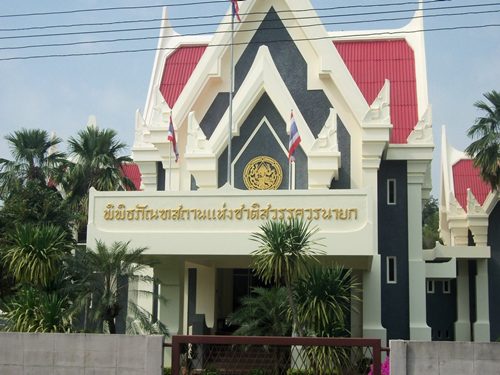
Aside from architectural and Buddha statue arts, Sukhothai is also known for its most famous product and export: ancient ceramics. The practice has been passed down from generation to generation.
Archaeological finds of ancient kilns in Muang and Si Satchanalai districts point to the assumption that villagers in these two areas produced ceramics.
Visitors can witness this ancient production now adapted to fit the modern world’s trade. Head to communities around Wat Trapangngoen and Wat Trapangthonglang, not far from Sukhothai Historical Park, to see the production in person. There you’ll find shophouses manufacturing a variety of products. In Si Satchanalai, which had been the center of Sangkhalok manufacturing for at least four centuries, Baan Koh Noi (+6655 613 790) is the perfect location to try painting porcelain as a souvenir to take back home.
Sangkhalok Museum (+6655 614 333) in Ban Lum Sub-district, Muang district, is a small but comprehensive museum. You will get an excellent introduction to ancient ceramics manufacturing with about 2,000 pieces of an impressive collection of original Thai pottery found in the area. They are displayed together with samples from Myanmar, Vietnam, and China.
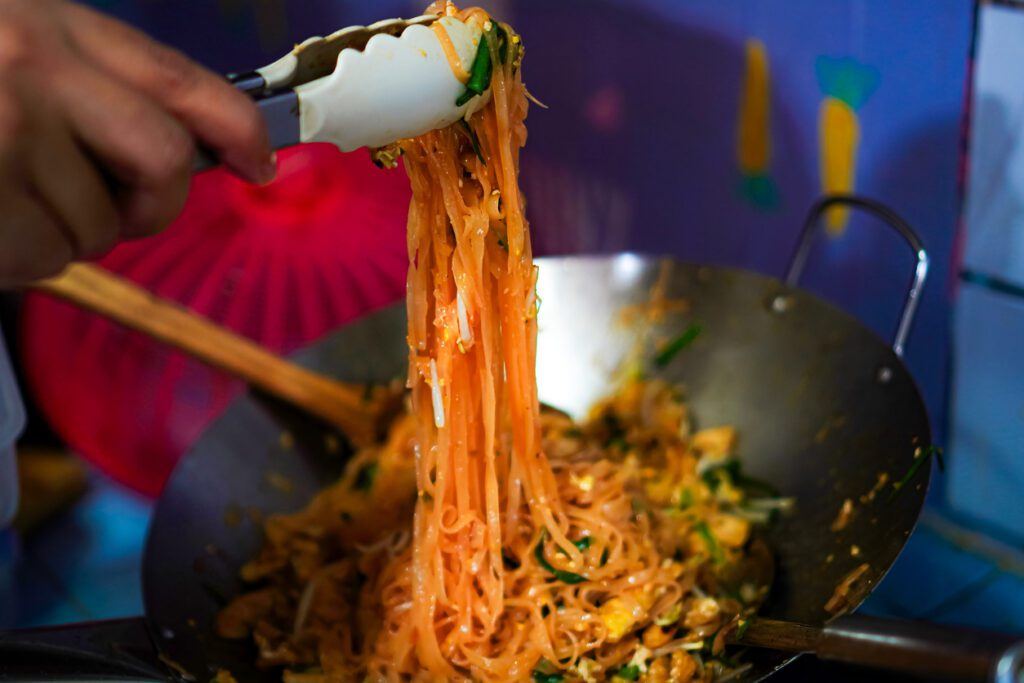
Epicures will find Sukhothai divine as the province has so many mouth-watering dishes capable of making anyone drool at the mention of their names. Sukhothai-styled noodle soup and Pad Thai are two of the palate-pleasing meals keeping visitors full and satisfied.
If you happen to be in Sukhothai on Friday or Saturday, when the Talad Thanam Rub Saded market operates, you can try a slew of local food. This famous walking street pops up twice weekly beside the King Ramkhamhaeng Monument within Sukhothai Historical Park between 5pm and 9pm. It’s heaven if you are fond of street foods, arts, and crafts. The sunset scene at Wat Sa Si and local folk dance performances make the whole event even more incredible.
There are eateries famous for local dishes like Sukhothai-styled Pad Thai and rice noodles for those preferring something more specific. Among the top choices are Kuaitiao Sujin, Jay Hae, Sweet Rice Cafe, Kuaitiao Tapui, Baan Kru-iw, Reuan Thai Hotel, and Mai Klang Krung.
Jay Hae on Jarodvithithong Road is open daily from 7am–4pm. Tel. +6655 611 901.
Tapui is about 1.3 kilometers west of the Yom River off Jarodvithithong Road. It is open daily from 7.30am–4pm. Tel. +6684 686 8928, +6655 620 435
Poo on Jarodvithithong Road is open daily from 9am–10pm. Tel. +6693 197 4070.
There are two more specialties in Sukhothai undoubtedly worth trying. Both Khao Perb and Kuay Teow Bae are served at a home-based restaurant in Si Satchanalai. Khao Perb Yai Krieng is at Baan Na Ton Chan, renowned for its award-winning homestay tourism. Their legendary tasty dishes are served daily from 8am – 5pm. Khao Perb is steamed-rice flat noodles with an assortment of fillings and only found at the village. Kuay Teow Bae is similar to small dry noodles, but all ingredients are cooked in a steamer pot. Call +6656 677 3264, +6687 036 0060, if you want to make sure there is a table available for your group.
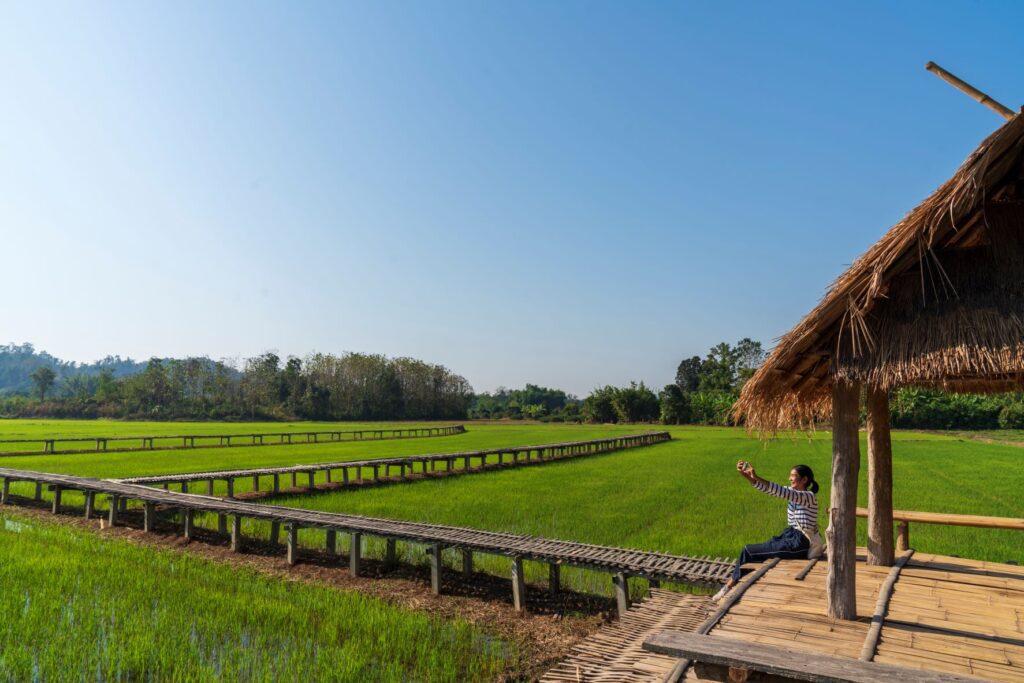
There’s more to this homestay village than the delicious Khao Perb.
Na Ton Chan Village, or Baan Na Ton Chan, is a small community in the Baan Tuek sub-district of Si Satchanalai district. After emerging onto the international tourism scene in 2012 at PATA Gold Awards as the winner in the prestigious Heritage & Culture category, it has developed into a major attraction in its own right. It has continued to collect more accolades since.
Now the charming village attracts visitors with sustainability-based tourism and everything that has become its by-products.
Here at Na To Chan, you can immerse yourself into homestay service at its best. Local villagers provide lodging to visitors, allowing them to witness the local way of living up close. Most of the hosts are farmers, some of which create mud-soaked textiles that have gained recognition nationwide. Basketry and other products are also the results of their hardworking nature. Visitors can learn some basic basketry and weaving techniques, learn to cook local dishes, and explore the fruit orchards, among other activities.
Staying overnight gives you a glimpse into rural living. Get up early to join the food alms offering to monks. You can also engage in a conversation regarding Buddhism and the life philosophy during the monk chat session regularly arranged afterward. Feel free to enjoy the fresh, clean air in the village on foot or by bike. If you have more than a night to spend, you can opt to see the spectacular sunset up in the mountains. The laid-back ambiance is sure to help one feel recharged amid the surrounding nature and warm hospitality.
A dozen villagers form a group of homestay owners providing accommodation to tourists and with a system in place to keep their quality intact. Each has to make sure that their service standard never drops or they risk losing their membership.
Na Ton Chan Village Homestay in Baan Tuek sub-district, Si Satchanalai district +6688 495 7738.
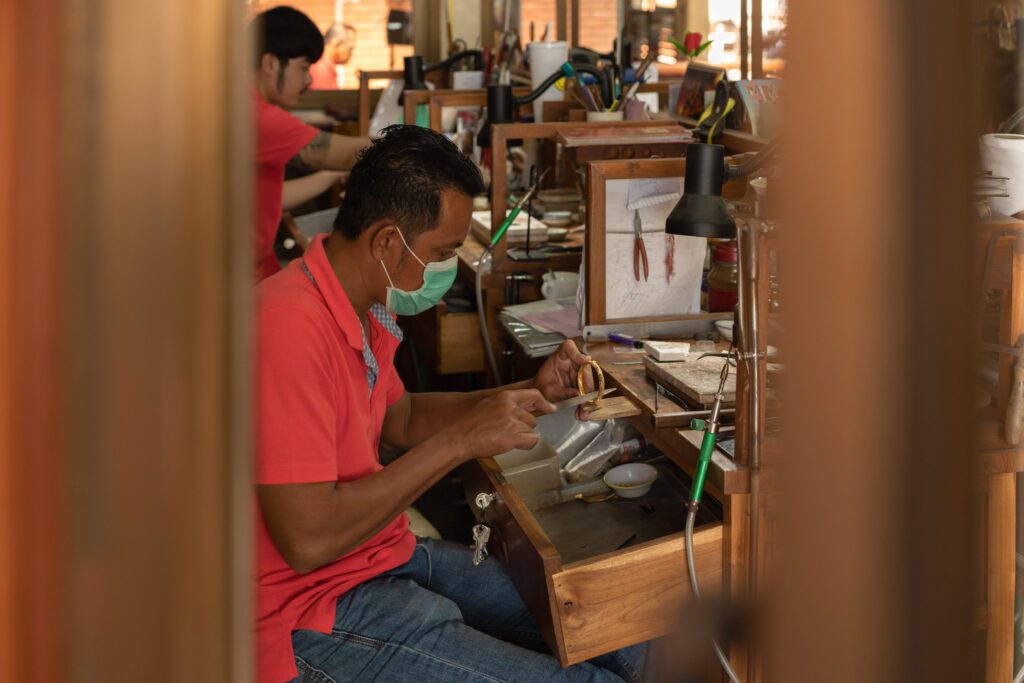
When the Sukhothai Kingdom was in its zenith, royal goldsmiths alone manufactured gold jewelry. Over time people of the area lost the skill. During the Ratanakosin era in 1930, local goldsmith families revived their gold making heritage, combining their knowledge with techniques they learned from Chinese artisans. They developed a new set of skills, passing it down from generation to generation. It was all custom made at first until the discovery of ancient bronze weaving patterns along the Yom River. These patterns were not something familiar in the market then. Local goldsmiths were keen on studying them and later managed to apply those patterns to their gold making process. Hence the Sukhothai gold jewelry we have come to know nowadays.
There are quite a few families that continue their business using these special techniques. Some keep it simple, while a few manufacturers use some modern designs to attract a wider range of customers.
Somsamai Gold House is one of the pioneers in the business and remains one of the most famous. Call. +6655 679 095 or check their website.
Somsak Gold in Ta Chai Sub-district has also been in business for a long time. Check their website or call +6655 679 1867
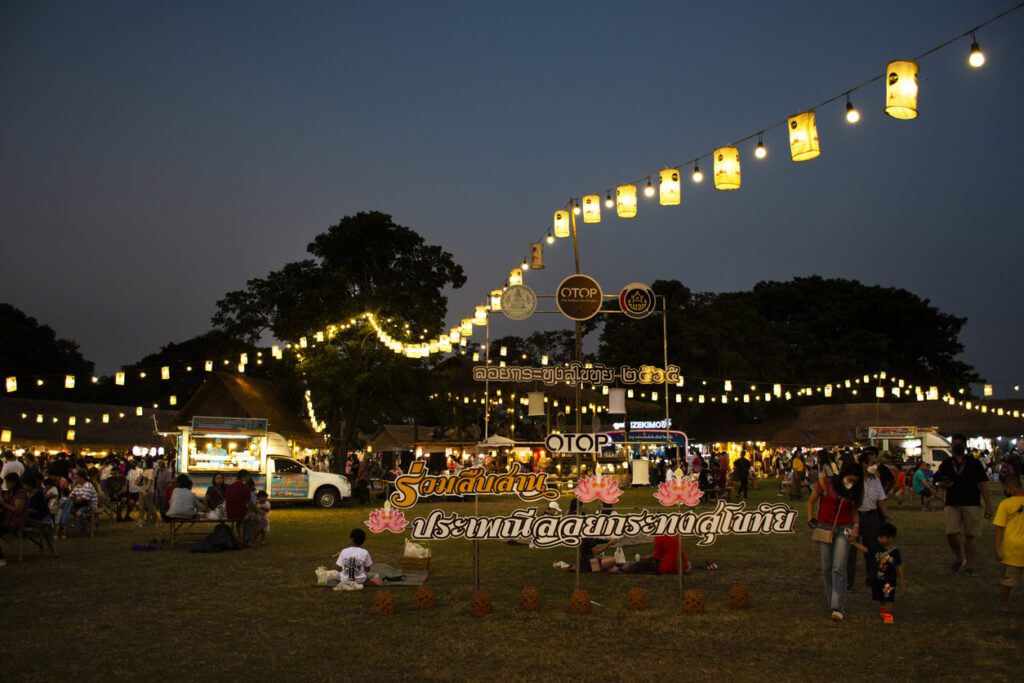
Though tiny in size, Sukhothai’s night market every Saturday evening is vibrant and full of energy. After sunset, the city dwellers gather on a road lined up with vendors accustomed to servicing foreign visitors. You can savor delicious local dishes such as Sukhothai-style noodles with soup and Pad Thai. This small market space is a venue for performances as well, adding some lively entertainment.
For foodies, this is a must-visit place to enjoy local cuisine at a reasonable price in a great atmosphere. Sukhothai Night Food Market in Muang district is open from sunset until midnight.
